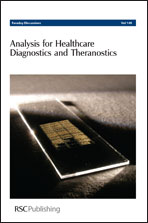Exploiting the diagnostic potential of biomolecular fingerprinting with vibrational spectroscopy
Abstract
There is immense clinical need for techniques that can detect the biochemical changes associated with pre-malignancy. The ideal diagnostic test would provide rapid, non-invasive diagnosis at the point of care with high throughput and without prior tissue processing. Over the past decade
- This article is part of the themed collection: Analysis for Healthcare Diagnostics and Theranostics

 Please wait while we load your content...
Please wait while we load your content...